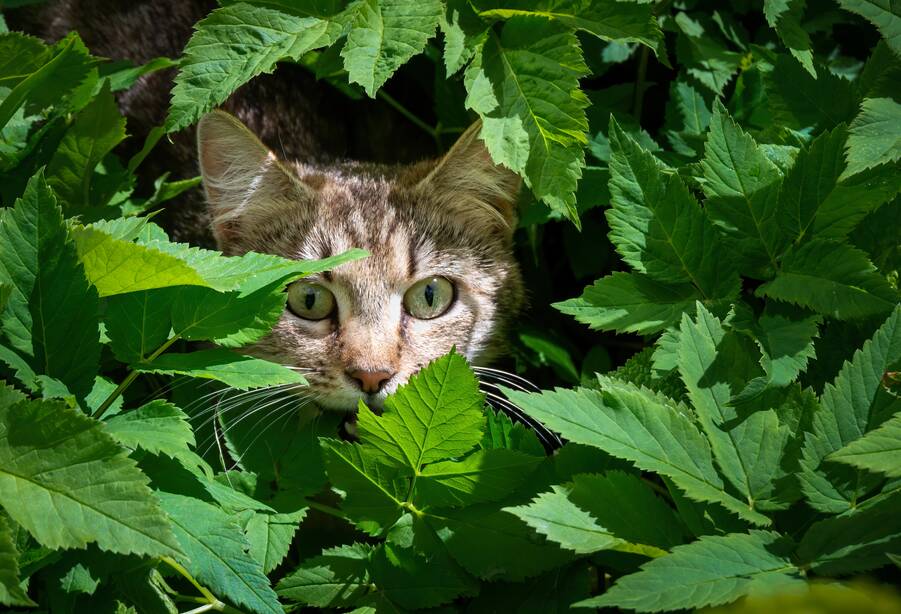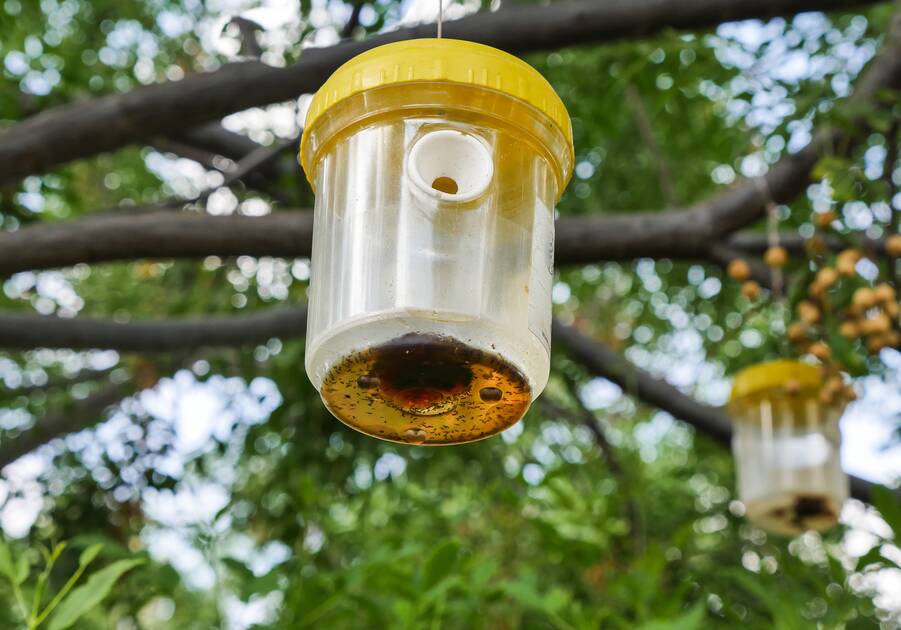
I have just been tromping around in the ankle-high wet grass that for a short time after mowing we refer to as "lawn", rebaiting our household's traps. We have accumulated traps for quite a number of species.
The first was the fox trap that Bryan made out of a donated (legally) old supermarket trolley. It's caught many foxes, as well as feral cats. How do we know the cat are feral? Feral moggies are trying to bite their way through the steel and our jugulars. A domesticated cat sits there neatly, extremely annoyed, waiting to be fed, and then rehomed.
The trolley trap has also caught an embarrassed dog, a confused wombat, and a cross currawong, all quickly released - we only keep the trap set when we can watch it. It's baited with a can of sardines in oil with a few small holes in it. The aroma lasts for months.
The fly traps sit above the chook house and the kitchen. We made our own ones for years, out of old soft drink bottles baited with egg mixed with prawns covered in oil and water. We now use commercial ones, with a commercial bait. Swallows and other birds sometimes perch next to them, to eat the flies before they are trapped, a kind of bird take-away.

Rats are unwelcome in our garden - a mob of rats can clean out a crop of corn overnight, and they are probably introduced rats, not native ones, which we have here too. This is why we don't use bait. Bait also kills non-target species when they eat the dying rats, and if the rats die behind the fridge or in the ceiling, you have a sweet and horrible stench for weeks.
Instead, we used live traps, baited all the time with a hunk of fruit and nut chocolate. Unlike cheese or peanut butter, the chocolate keeps its scent for months.
If you just want to rid your roof of rats, you might consider a tame python, or, just possibly, a couple of pet white rats. "White rats" are brown rats, bred to be white, and black rats are said to be scared of the scent of brown rat. I haven't tried this, but if you are looking for a small pet, a white rat in a roomy cage with plenty of toys may also be useful. Scatter it's droppings in the roof cavity.
We don't use possum traps, no matter how many fruit trees Possum X defoliates or how much he yells at us if we have friends for afternoon tea and wake him up with our laughter. If you move a possum, if will almost certainly die trying to get back home, driven out by the possums already resident there. Instead, we now use "possum deterrents". I'm seeing which works best - commercial spiked anti-possum mats that need to be nailed on - useful on pergolas but not fruit trees - or brass netting that can be taped around the tree, deeply irritating to possum claws.
Fruit fly netting will keep possums and birds from your fruit, tomatoes and other veg as well as deterring fruit fly, as long as you tie it on securely, leaving no easy gaps. We don't use bird netting, as micro bats can get caught in it, and we need the micro bats to keep down the mozzies, and the fruit bats to pollinate bush plants. Snakes also get caught in bird netting. Removing a scared and angry snake is not fun for either you or the snake.
This is the second year I've been putting out European wasp traps, which began to invade the area about a decade ago, and are spreading fast. You can buy ready-made ones, with a lure that doesn't attract bees. I haven't found a successful home-made bait that doesn't attract bees or hoverfly, both of which are badly needed in out garden, so commercial traps it is, hung near water, or along pathways. European wasps are lazy, and will head along a nice straight path if they can find one. They also like to near water. All our paths now have bait stations along them, refilled every few weeks from August to June.
Mouse traps are more fun. I came up with a design about 40 years ago, when we discovered we had either New Holland or Smoky mice living here. (The guy at CSIRO wasn't sure when we brought in three of them - they had got caught in our sink. Once identified as native, we released them, and now use only this simple trap: stretch wire across a four-gallon drum or large garbage can, threaded with a cardboard roller from inside baking paper, or even toilet rolls. Wire fruit and nut chocolate onto the roll. The mice will run along the wire, step on the roll and fall into the trap. It's possible someone invented the idea pre 1978 i.e. before I did, but I haven't seen the design anywhere else for about 30 years, when it grew popular.
Bring your courage and work out if any rats or mice you catch are native. Native bush rats have a tail shorter than their body length and round ears. Introduced rats have a tail longer than their body length, and not much hair on their tails. It can be hard to tell the difference with young rats though.
Native mice have bulging eyes, round ears and look cute and fluffy, though I may be biased here. But they do look ... different. If you are lucky enough to have native antechinus, which look like mice, look for the classic long pointed narrow nose. Mice have rounded heads and rounded noses.
There are other ways that experts use to identify small, rodent-like species, but most of us don't want to begin checking teeth etc. When in doubt, look at identification sites online, or head down to the library for a useful guide.
There is one more deterrent I have never used, but would love to - a motion-sensing scarecrow that squirts a jet of water at anything that moves. It will scare away cockatoos, possums, next door's cat, and possibly the post person - anything you want deterred, and some that you don't. They also look great fun for kids, and possibly grandmas too on hot summer days, running to see if we can beat the motion sensor. But motion-sensing scarecrows cost between $150 and $250, and as we have deterrence pretty much covered, it would be indulgent to get one, even under the pretext of seeing how well they work, and which works best.
Actually, there is one pest we no longer try to deter - the white cockatoos. Every year they eat our walnuts. We have tried many, many deterrents. None worked, though the cockatoos did learn to fly like stealth bombers, utterly silent under the tree line.
Finally we decided the cockatoos could have the walnuts, but when they began to gaze at the apples and corn by the house, I had a quick rethink. Luckily a resident white goshawk scared them away from the house before they had more than nibble at a few mandarins for the seeds. It still does, though possibly it isn't the same white goshawk - it's hard to tell. But there has been one on duty when needed for the last three decades, the perfect deterrent, there when you need it, with no work from you.
This week I am:
- Feasting on green, purple and white asparagus, fresh peas, the first not-quite-sweet mulberries and the berries of the red-flowered strawberries. Both plant and berries are magnificent.
- Picking roses, roses, roses, as each day a new variety begins to bloom.
- Weeding, weeding and yet more weeding, despite mulching too. I have never known a season of so many weeds.
- Also mowing. Please send another 200 kangaroos to keep the grass in check.
- Watching the tomatoes set their first fruit, the cucumbers and melons germinate, planting more corn, beans and lettuce so we get a succession of harvest.
- Rejoicing - my beloved purple-leafed smoke bush died four years ago in the last year of drought. But this spring, suddenly, there are half a dozen rich purple-leafed stems growing even faster than the weeds.
We've made it a whole lot easier for you to have your say. Our new comment platform requires only one log-in to access articles and to join the discussion on The Canberra Times website. Find out how to register so you can enjoy civil, friendly and engaging discussions. See our moderation policy here.







